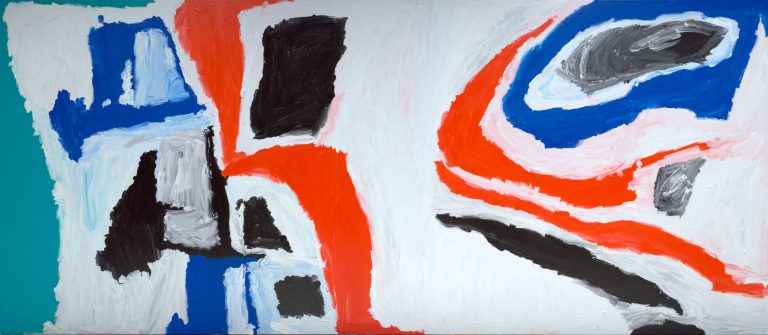We acknowledge the Traditional Owners of the land on which the Queensland Art Gallery | Gallery of Modern Art stands and recognise the creative contribution First Australians make to the art and culture of this country.

Mirdidingkingathi Juwarnda Sally Gabori / Kaiadilt people / Australia c.1924–2015 / Makarrki‘ 2008 / Synthetic polymer paint on linen / 197.8 x 453.8cm / Gift of the Estate of Mirdidingkingathi Juwarnda Sally Gabori through the Queensland Art Gallery | Gallery of Modern Art Foundation 2017 / © Mirdidingkingathi Juwarnda/Copyright Agency
Mirdidingkingathi Juwarnda Sally GaboriMakarrki’ 2008
On Display: QAG, Gallery 2
Makarrki‘ 2008 is a major, large-scale painting from a period when Gabori’s technique and confidence developed exponentially. As she continued to paint, Gabori established a unique painting style, where she would lock her brush firmly into her hand and paint with a gestural action initiated by her shoulder. Her highly energetic movements suited painting on larger surfaces and through 2008 many vibrant, tropical toned works were produced in scales between three to six metres in length.
Sally’s paintings of Makarrki are layered with complex memories and intense emotions. The head of the Makarrki River, at the heart of the northern shore of Bentinck Island, was an important hunting ground and Sally often recalled the exploits of her ‘brother’ (brother-in-law) Tarurukingathi Kulkitji (Buddy) wrestling with dugongs there. It was also the country of her older brother, Makarrkingathi Dingkarringathi Thuwathu Bijarrb (King Alfred).
King Alfred was the leader of the main Kaiadilt clan in the years prior to their removal to Mornington Island. He is remembered by his family as a strong warrior and leader. In the late 1940s a period of great drought caused tremendous friction within Kaiadilt society and conflict was common. In a fateful turn of events King Alfred took the life of Buddy, before Buddy’s brother, Kabararjingathi Bulthuku Pat Gabori killed the King and took his younger sister, Sally, as his wife.
Although this work, as with many of Gabori’s works, was not directly interpreted by the artist, a number of recurrent symbols and styles are present. At the right is a solid dark oval form, surrounded by bands of colour radiating outward, indicating one of the many small islands at the river mouth, being embraced by lapping water as it races in or out of this great tidal estuary or a dugong creating ripples on the surface of the water as it breaks the surface. To the left is a complex arrangement of geometric forms, most likely indicating the rock-walled fish traps that line the mouth of the river near Sally’s family’s camp.
Endnotes:
Essay and biographical details by Bruce Johnson McLean, Curator, Indigenous Australian Art, July 2017
Mirdidingkingathi Juwarnda Sally Gabori (c.1924–2015) came to painting at the age of 81. She was one of a handful of leading artists from Indigenous communities who worked in a bold personal style outside the established traditions of painting country. Others include Emily Kame Kngwarreye, Ginger Riley, Makinti Napanangka, Wakartu Cory Surprise and Nora Wompi.
Gabori is widely acclaimed for her vibrant use of colour depicting the intimate connections between the Kaiadilt people of Bentinck Island, their country and their history.
For her first 23 years, she moved between her family’s main homeland sites, living according to her unbroken ancestral culture. Then, in 1948, following devastating drought, storms and a near 4-metre tidal surge, she and her kin were moved to nearby Mornington Island.
Gabori returned to Bentinck Island whenever possible and maintained a strong connection to her Kaiadilt country through language, song and storytelling, all of which she incorporated into the act of painting.